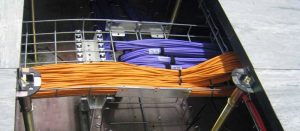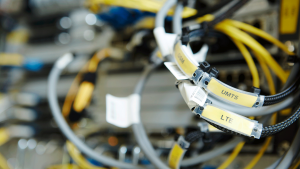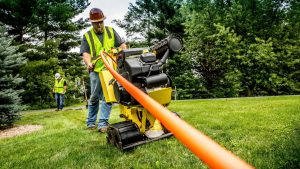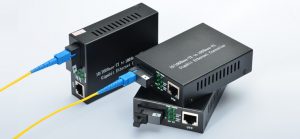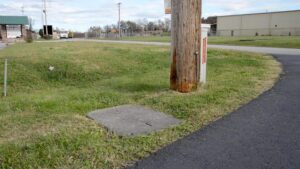A passive optical network (PON) is a point-to-multipoint, shared optical fiber to the premises network architecture in which unpowered optical splitters are used to enable a single optical fiber to serve multiple premises, typically 64–128.
Passive optical networks are typically passive, in the sense that they employ a simple passive optical splitter and combiner for data transport. A PON takes advantage of wavelength division multiplexing (WDM), using one wavelength for downstream traffic and another for upstream traffic on a single Non-zero dispersion-shifted fiber (ITU-T G.652).
Optical Line Terminal OLT
The Optical Line Terminal (OLT) is the main element of the network and it is usually placed in the Local Exchange and it’s the engine that drives FTTH system. The most important functions that OLT perform are traffic scheduling, buffer control and bandwidth allocation.
OLTs typically operate using redundant DC power (-48VDC) and have at least 1 Line card for incoming internet, 1 System Card for on-board configuration, and 1 to many GPON cards. Each GPON card consists of a number of GPON ports.
Optical Splitters
The optical splitter splits the power of the signal. That is each link (fiber) entering the splitter may be split into a given number of fibers leaving the splitter and there is usually three or more levels of fibers corresponding to two or more levels of splitters.
This enables sharing of each fiber by many users. Due to power splitting the signal gets attenuated but its structure and properties remain the same. The passive optical splitter need to have the following characteristics:
- broad operating wavelength range
- low insertion loss and uniformity in any conditions
- minimal dimensions
- high reliability
- support network survivability and protection policy
Optical Network Terminal ONT
Optical Network Terminals (ONTs) are deployed at customer’s premises. ONTs are connected to the OLT by means of optical fiber and no active elements are present in the link. In GPON the transceiver in the ONT is the physical connection between the customer premises and the central office OLT.
WDM triplexer module separates the three wavelengths 1310nm, 1490nm and 1550nm (for CATV service). ONT receives data at 1490nm and sends burst traffic at 1310nm. Analogue video at 1550nm is received. Media Access Controller (MAC) controls the upstream burst mode traffic in an orderly manner and ensures that no collision occur due to upstream data transmission from different homes.
They are fiber to copper media converters that offer RJ11, RJ45, and F-Series connectors to any device. These devices are available in many configurations and port densities up to 24 ports. ONTs are available for outdoor and indoor use, provide POE or no POE, 10/100/1000, AES encryption, and can include batteries for survivability in the event of a power outage.
GPON uses Dynamic Bandwidth Allocation that is it dynamically allocates the bandwidth depending on the number of packets available in the T-CONT. Once the OLT reads the number of packets waiting in T-CONT it assigns the bandwidth. If there are no packets waiting in the T-CONT, then OLT assigns the bandwidth to other T-CONT which have packets waiting in T-CONT.
If an ONT has a long queue OLT can assign multiple T-CONTS to that ONT.
GPON FTTH ACCESS NETWORK ARCHITECTURE
GPON’s have a tree topology in order to maximize their coverage with minimum network splits, thus reducing optical power. An FTTH access network comprises five areas, namely a core network area, a central office area, a feeder area, a distribution area and a user area.
In the core network area is not considered as a part of the FTTH access network. The network architecture adopted by this article is to use two level of splitting between the central office and the user premises achieving an overall splitting ratio of 1:64.
Level one splitter is 2:4 where the digit 2 comes from type B protection to be explained later. The distance between the OLT and ONT may be more than 20 km depending on the total available optical power budget, which is a factor of the OLT laser port and the total loss budget.
FTTH Core Network
The core network includes the internet service provider ISP equipments (typically BRAS and AAA server), PSTN (packet switched or the legacy circuit switched) and cable TV provider equipment.
Central Office
The main function of the central office is to host the OLT and ODF and provide the necessary powering. Sometimes it might even include some (or all) of the components of the core network.
FTTH Feeder Network
The feeder area extends from optical distribution frames (ODF) in the central office CO to the distribution points. These points, usually street cabinets, called Fiber Disruption Frames FDT where level-1 splitters usually reside. The feeder cable is usually connected as ring topology starting from a GPON port and terminated into another GPON port to provide type B protection.
Level-1 splitters with a spilt ratio of 2:4 have been employed by our design. This type of splitters enables the feeder to be connected to 2 GPON ports from one side (for type B protection) and feeds a total of 4 distribution cables from the other side. The fiber cable running between the CO and level-1 splitter is called Level-1 fiber.
FTTH Distribution Network
Distribution cable connects level-1 splitter (inside the FDT) with level-2 splitter. Level-2 splitter is usually hosted in a pole mounted box called Fiber Access Terminal FAT usually placed at the entrance of the neighborhood. In the design level-2 splitter is 1:16, which means each FAT serves 16 homes. The fiber cable running between level-1 splitter and level-2 splitter is called level-2 fiber.
User Area
In the user area, drop cables, or level-3 fibers, are used to connect the level-2 splitter inside the FAT to the subscriber premises. Drop cables have less fiber count and length ranges up to 100 meters. Drop cables are designed with attributes such as flexibility, less weight, smaller diameter, ease of fiber access and termination.
For ease of maintenance, usually an aerial drop cable is terminated at the entrance of the subscriber home with a Terminal Box TB, then an indoor drop cable connects the TB to an Access Terminal Box ATB reside inside the home. Finally a patch cord connects the ONT to the ATB.
It is most important that the optical fibers are distributed in such a way that efficient design, construction, maintenance and operation for FTTH is achieved. Therefore, in order to determine the network architecture, design, construction, maintenance, and operation approach for the optical access network, and to select optical components for FTTH, telecommunication companies should mainly consider the followings:
- Scalability
- Survivability
- Functionality
- Construction and maintenance costs
- Network upgradeability
- Operability and suitability over designed network lifetime. Read Full PDF


